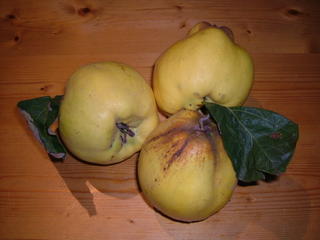 I didn’t make any quince jelly last year; the quinces on the tree at my Mum’s house came ripe and then dropped off while I was busy getting married and going on honeymoon. This was an ill-considered piece of timing on my part, and resulted in a year of married bliss with no quince jelly. Catastrophe. This needed putting right before we found each other weak and snappish at the lack of sugar, our marriage under intolerable, hypoglycaemic strain.
I didn’t make any quince jelly last year; the quinces on the tree at my Mum’s house came ripe and then dropped off while I was busy getting married and going on honeymoon. This was an ill-considered piece of timing on my part, and resulted in a year of married bliss with no quince jelly. Catastrophe. This needed putting right before we found each other weak and snappish at the lack of sugar, our marriage under intolerable, hypoglycaemic strain.
Quinces are a lot like a large pear in appearance; they’re also covered with a soft, furry down. They smell extremely fragrant, but they’re not edible raw; a raw quince is very hard, astringent and bitter. Cooked, however, they change in character completely. They lose their golden-yellow colour and their tart taste, and become pinkish, soft and intensely scented.
When I make quince jelly, I follow Mrs Beeton’s recipe. (There are only a very few of Mrs Beeton’s recipes I would happily cook from, but her preserves are usually excellent, and, of course, preserving was much more important to the refrigerator-free Victorians than it is to us.) It’s very simple – all you need is quinces, water and sugar. She says:
INGREDIENTS – To every pint of juice allow 1 lb. of loaf sugar.
Mode – Pare and slice the quinces, and put them into a preserving-pan with sufficient water to float them. Boil them until tender, and the fruit is reduced to a pulp; strain off the clear juice, and to each pint allow the above proportion of loaf sugar. Boil the juice and sugar together for about 3/4 hour; remove all the scum as it rises, and, when the jelly appears firm when a little is poured on a plate, it is done. The residue left on the sieve will answer to make a common marmalade, for immediate use, by boiling it with 1/2 lb. of common sugar to every lb. of pulp. Time – 3 hours to boil the quinces in water; 3/4 hour to boil the jelly.
(If you prefer metric measurements, use 600ml of juice to every 450g of sugar.)
Quinces are, as I mentioned above, absolutely rock-hard. I sharpened my big cook’s knife until it had an edge that would put a samurai sword to shame, and started to lay about the quinces, helping the task along by imagining the faces of countless enemies on each one. (I bear grudges for decades. It provides me with excellent chopping-fuel.)
 Ripe quinces often have small brown patches inside, as in this picture (they’ll get browner as they sit in your pan and the oxygen gets to them, too). Don’t worry. It doesn’t mean your quince is bad. My Mum, who taught me to make this, always insisted that it’s important that you leave the seeds in, but I do wonder whether she’s confusing quinces with citrus fruits, where the seeds are important in jam-making for the pectin, the enzyme which makes the jam gel properly. I give her the benefit of the doubt and leave them in anyway. I also deviate a little from Mrs Beeton here; I don’t pare (peel) the quinces, having discovered a few years ago that it doesn’t make any difference to the finished jelly; you’ll want to peel them if you intend on making the marmalade (quince cheese) that she mentions, but I’m not intending on doing that; there’s little enough room in my cupboards as it is.
Ripe quinces often have small brown patches inside, as in this picture (they’ll get browner as they sit in your pan and the oxygen gets to them, too). Don’t worry. It doesn’t mean your quince is bad. My Mum, who taught me to make this, always insisted that it’s important that you leave the seeds in, but I do wonder whether she’s confusing quinces with citrus fruits, where the seeds are important in jam-making for the pectin, the enzyme which makes the jam gel properly. I give her the benefit of the doubt and leave them in anyway. I also deviate a little from Mrs Beeton here; I don’t pare (peel) the quinces, having discovered a few years ago that it doesn’t make any difference to the finished jelly; you’ll want to peel them if you intend on making the marmalade (quince cheese) that she mentions, but I’m not intending on doing that; there’s little enough room in my cupboards as it is.
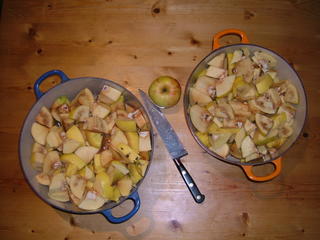 About twenty chopped quinces fill my two largest Le Creuset pans. I’ve plonked my knife and an apple between the pans so you can get an idea of scale – these pans are 26 and 28cm in diameter – this is a lot of chopped quince. The largest pan (the blue one) needs about three litres of water to fill it enough to make the quince bits bob about merrily, the orange pan about two and a half. Simmering for three hours will reduce the quince to a pulp in a gorgeously pink juice, and will scent your whole house with a honeyed, fruity perfume.
About twenty chopped quinces fill my two largest Le Creuset pans. I’ve plonked my knife and an apple between the pans so you can get an idea of scale – these pans are 26 and 28cm in diameter – this is a lot of chopped quince. The largest pan (the blue one) needs about three litres of water to fill it enough to make the quince bits bob about merrily, the orange pan about two and a half. Simmering for three hours will reduce the quince to a pulp in a gorgeously pink juice, and will scent your whole house with a honeyed, fruity perfume.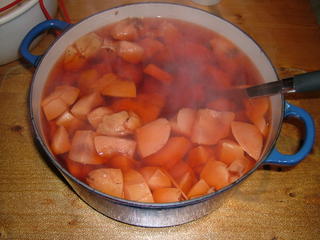
I used to strain jellies by lining a sieve with butter muslin and balancing it precariously on top of the bowl I was straining the jelly into. This year I have seen sense and bought a proper jelly bag from Lakeland. I’m not impressed; the metal stand is coated with red plastic, but the plastic is flaking off the ring around the top as if it’s got a particularly nasty skin disease. I need to be careful that none of it ends up in the jelly.
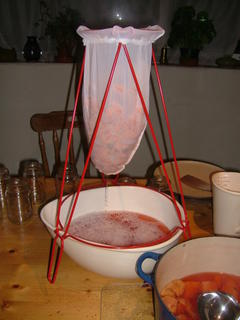 The bowl I want to strain into is too big for the stand. It has to balance on it precariously. My hairy-handed sous chef, Mr Weasel, will need to hold it steady when I put the pulp in the bag.
The bowl I want to strain into is too big for the stand. It has to balance on it precariously. My hairy-handed sous chef, Mr Weasel, will need to hold it steady when I put the pulp in the bag.
Quinces contain enough pectin to gel naturally, but the set you get from quince-pectin alone is quite soft. I prefer a harder set, so I use jam sugar, which comes with pectin already added.
The orange pan yields five pints of juice, the blue one six. Bugger, that’s a lot. I don’t have enough jam jars. Today’s most shocking discovery is that it’s cheaper to buy Tesco Value marmalade and throw it away (31p per jar – and this is difficult, because throwing perfectly good food away makes me feel physically ill – but what do you do with six lb of jarless, cheap jam?) than it was to buy my pristine jars and lids from Lakeland (about 50p, including the lid, which has to be bought separately). Mr Weasel, craving jelly, drives to Tesco and buys six jars of sacrificial marmalade.
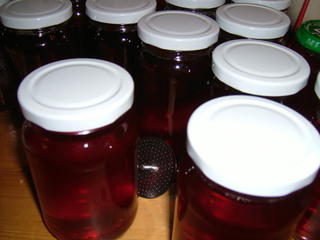 After 45 minutes of simmering (with no lid), 22lb (10 kilos) of quince jelly is ready to go into the sterilised jars. This should be enough to go on crumpets, accompany and glaze roast lambs, drizzle over blue cheeses and make presents for the neighbours until next autumn.
After 45 minutes of simmering (with no lid), 22lb (10 kilos) of quince jelly is ready to go into the sterilised jars. This should be enough to go on crumpets, accompany and glaze roast lambs, drizzle over blue cheeses and make presents for the neighbours until next autumn.
The recent glut of tomato recipes (the result of a glut of tomatoes) should end with this one, I hope; semi-preserving tomatoes by roasting all the moisture out of them and marinading in olive oil produces something so good that I think I’ll be roasting all my future tomatoes too this year. It’s a good method for dealing with large number of tomatoes, because when cooked in this way they reduce in volume so dramatically. The few pounds of raw tomatoes I cooked here resulted in about a jam-jar full of finished tomatoes.
Arrange the tomatoes in a single layer, cut sides up, on a baking tray. Sprinkle over all the dry ingredients evenly, and drizzle olive oil over the cut surfaces. Make sure you use plenty of freshly ground black pepper, which will help the tomatoes’ flavour sing.






